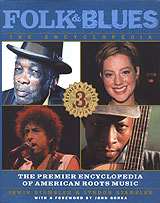
Beautiful writing defines folk/blues reference
|
This review first appeared in the American Reporter in 2001.
If you're looking to learn more about rock music, there are literally dozens of guides and encyclopedias from which to choose. Classical, jazz and blues have their share, too. Folk music is a bit tougher, though, at least of late.
While both the 1960s and the '80s saw mini folk-booms, folk is the original "alternative" music. By it's very nature it disdains much of the corporate support structure available to other musics. Whatever is popular on the radio, folk goes in the opposite direction – if only to make a point.
So for the listener just exploring folk, learning which albums to buy, or getting a handle on who's played with whom can be a bit tougher than for fans of other styles.
Now Irwin and Lyndon Stambler have co-written "Folk and Blues: The Encyclopedia," which aims to fill in that gap.
It's a joyous celebration of everyone from Woody Guthrie to Bob Dylan to Carrie Newcomer.
Each entry includes detailed biographical information, plus mention of the artist's more noteworthy recordings. The entries aren't really encyclopedic in nature or tone, though – they are more like magazine articles, with a nice narrative flow that makes for better reading than most encyclopedias.
The blues entries are not intentionally being overlooked here. The reality is, though, that there are already in existence many similar books on the blues – by writers with as much if not more knowledge of the music than the Stamblers, most notably Paul Oliver's many books. The same is not true of folk, and so their contribution here is the more important.
Also to their credit is the fact that the British folk scene is well-represented. Pentangle, Fairport Convention and Lindisfarne all get the same star treatment as American heroes John Fahey or Taj Mahal.
For all that, it's not perfect. Most glaringly, there's the inherent conflict of interest of having an artist included in this book – John Gorka – writing the foreword. How reliable does that make Gorka's entry seem to the reader? The authors really ought to have been able to find a respected writer on blues and folk – Peter Guaralnick, say – to write the foreword.
Then there are the rock acts that have snuck in here. Sure, there is some crossover, and a Dylan certainly belongs here, as do Crosby Stills and Nash. But REM as folk combo? If you're going that far, then how can you overlook the Pogues?
Finally, there's also the overlap from Irwin Stambler's earlier "Encyclopedia of Folk, Country and Western Music." For instance, the Austin folk scene is one of the most fertile going today. Yet you won't find Guy Clark or Jimmie Dale Gilmore – stalwarts of that Austin folk scene – but you do find Tish Hinojosa and the late Townes Van Zandt. J.D. Crowe and the New South – as hardcore a bluegrass combo as you'll find – is here, but not Laurie Lewis. One supposes that Clark, Gilmore and Lewis are in the Country collection, but it's hard to see why they're not here.
Perhaps a combined blues, country and folk super-encyclopedia will be forthcoming. In the meantime, make sure you have both if you want to cover the entire world of folk music.
Still and all, it's hard to imagine a single other source where you can learn about Steeleye Span and Pete Seeger, Flaco Jiminez and Elmore James.
